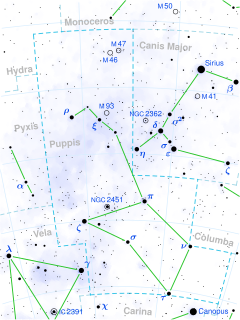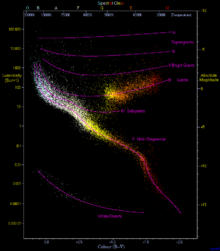Pi1 Ursae Minoris is a common proper motion binary star system in the northern circumpolar constellation of Ursa Minor. The pair have apparent visual magnitudes of +6.58 and +7.31, with a combined magnitude of 6.1. They are located about 71 light years from the Sun. The two have an angular separation of 31.4 arc seconds, which corresponds to a physical separation of about 680 AU, and orbit each other with a period of about 13,100 years.
HD 1237 is a binary star system approximately 57 light-years away in the constellation of Hydrus.
HD 172051 is a single, yellow-hued star in the southern constellation of Sagittarius. The star is barely bright enough to be seen with the naked eye, having an apparent visual magnitude of 5.85. Based upon an annual parallax shift of 76.64 mas, it is located some 43 light years from the Sun. It is moving away from the Sun with a radial velocity of +37 km/s.
HR 4458 is a binary star system in the equatorial constellation of Hydra. It has the Gould designation 289 G. Hydrae; HR 4458 is the Bright Star Catalogue designation. At a distance of 31.13 light years, it is the closest star system to the Solar System within this constellation. This object is visible to the naked eye as a dim, orange-hued star with an apparent visual magnitude of 5.97. It is moving closer to the Earth with a heliocentric radial velocity of −22 km/s.
HD 109749 is a binary star about 206 light years away in the constellation of Centaurus.
HD 178911 is a triple star system with an exoplanetary companion in the northern constellation of Lyra. With a combined apparent visual magnitude of 6.70, it is a challenge to view with the naked eye. The system is located at a distance of approximately 161 light years from the Sun based on parallax measurements, but is drifting closer with a radial velocity of −38 km/s.
HD 213240 is a possible binary star system in the constellation Grus. It has an apparent visual magnitude of 6.81, which lies below the limit of visibility for normal human sight. The system is located at a distance of 133.5 light years from the Sun based on parallax. The primary has an absolute magnitude of 3.77.
HR 6806 is a solitary, orange, main sequence, and Sun-like star located thirty-six light-years away, in the constellation Hercules. The star is smaller than the Sun, with around 79% of the solar mass and radius, and 35% of the solar luminosity. It appears to be rotating slowly with an estimated period of 42 days. In 1988, it was noticed that the star had an inactive chromosphere, with a surface magnetic field strength of only 1,500 G. From 1990 activity in the chromosphere increased, inline with a 16 year stellar cycle previously observed. But, sometime after 1994 chromospheric activity greatly reduced, and has stayed flat for more than 16 years. As of 2022, the star appears to have entered the equivalent of a Maunder minimum. The star is around six billion years of age.
HD 115404 is a binary star system located in the constellation Coma Berenices. Parallax measurements made by Hipparcos put the system at 36 light-years, or 11 parsecs, away. The combined apparent magnitude of the system is 6.52, with the magnitudes of the components being 6.66 and 9.50.

V538 Aurigae is a single star in the northern constellation of Auriga. With an apparent visual magnitude of 6.23, this star requires good dark sky conditions to view with the naked eye. It is located at a distance of 40.0 light-years (12.3 pc) from Sun based on parallax. The star is drifting further away with a radial velocity of 0.9 km/s. It is a member of the Local Association, and is most likely a thin disk star.
HD 126614 is a trinary star system in the equatorial constellation of Virgo. The primary member, designated component A, is host to an exoplanetary companion. With an apparent visual magnitude of 8.81, it is too faint to be seen with the naked eye. The system is located at a distance of 239 light years from the Sun based on parallax measurements, but is drifting closer with a radial velocity of −33 km/s.
HD 79498 is a primary of the star system located 159 light years away in the constellation Cancer. This G5 main sequence star has an apparent magnitude of 8.0 and is about the same size and mass as the Sun. It has a higher than solar abundance of elements other than hydrogen and helium; what astronomers term a metal-rich star.
HD 16754 is a binary or triple-star system in the constellation Eridanus. It has the Bayer designation s Eridani; HD 16754 is the designation from the Henry Draper catalogue. The system is visible to the naked eye as a faint point of light with an apparent visual magnitude of +4.74. It is located at a distance of approximately 132 light years from the Sun based on parallax, and is drifting further away with a radial velocity of +18 km/s. The system is a member of the Columba association of co-moving stars.
HD 91324 is a likely binary star system in the southern constellation of Vela. It is visible to the naked eye with an apparent visual magnitude of 4.89. The distance to HD 91324, as determined from its annual parallax shift of 45.6 mas, is 71.5 light years. It is moving further from the Earth with a heliocentric radial velocity of +21 km/s.
HD 126053 is the Henry Draper Catalogue designation for a star in the equatorial constellation of Virgo. It has an apparent magnitude of 6.25, which means it is faintly visible to the naked eye. According to the Bortle scale, it requires dark suburban or rural skies to view. Parallax measurements made by the Hipparcos spacecraft provide an estimated distance of 57 light years to this star. It is drifting closer with a heliocentric radial velocity of −19.2 km/s.
HD 76653 is a single star in the southern constellation Vela. It is faintly visible to the naked eye with an apparent visual magnitude of +5.71. Based upon an annual parallax shift of 41.08 mas as seen from Earth, it is located 79 light years from the Sun. The star is moving closer to the Sun with a radial velocity of −6 km/s. It is a probable co-moving companion of the nearby Delta Velorum; the two have an estimated physical separation of 2.2 ly (0.6605 pc) with similar proper motions. Both are likely members of the Ursa Major association.
HD 119124 is a wide binary star system in the circumpolar constellation of Ursa Major. With an apparent visual magnitude of 6.3, it lies below the normal brightness limit of stars that are visible with the naked eye under most viewing conditions. An annual parallax shift of 39.24 mas for the A component provides a distance estimate of 83 light years. The pair are candidate members of the Castor Moving Group, which implies a relatively youthful age of around 200 million years. HD 119124 is moving closer to the Sun with a radial velocity of −12 km/s.
HD 44120 is a wide binary star system in the southern constellation of Pictor. Although visible to the naked eye, it is a challenge to view having an apparent visual magnitude of 6.44. The system is located at a distance of 118 light years from the Sun based on parallax, but it is drifting closer with a radial velocity of −2 km/s. It has an absolute magnitude of 3.57.
HR 3750 is a binary star system in the equatorial constellation of Hydra at a distance of 101 light years. This object is visible to the naked eye as a dim, white star with an apparent visual magnitude of 5.4. It is receding from the Earth with a heliocentric radial velocity of 57.9±0.2 km/s. This binary is unusual because its eruptions do not seem to conform to the Waldmeier effect—i.e. the strongest eruptions of HR 3750 are not the ones characterized by the fast eruption onset. Kinematically, the binary belongs to the thick disk of the Milky Way galaxy - a population of ancient, metal-poor stars.
HD 72945 and HD 72946 form a co-moving star system in the northern constellation of Cancer. HD 72945 is a binary star that is dimly visible to the naked eye as a point of light with an apparent visual magnitude of 5.91. At an angular separation of 10.10″ is the fainter companion star HD 72946 at magnitude 7.25. It is being orbited by a brown dwarf. The system as a whole is located at a distance of approximately 84 light years from the Sun based on parallax measurements.








